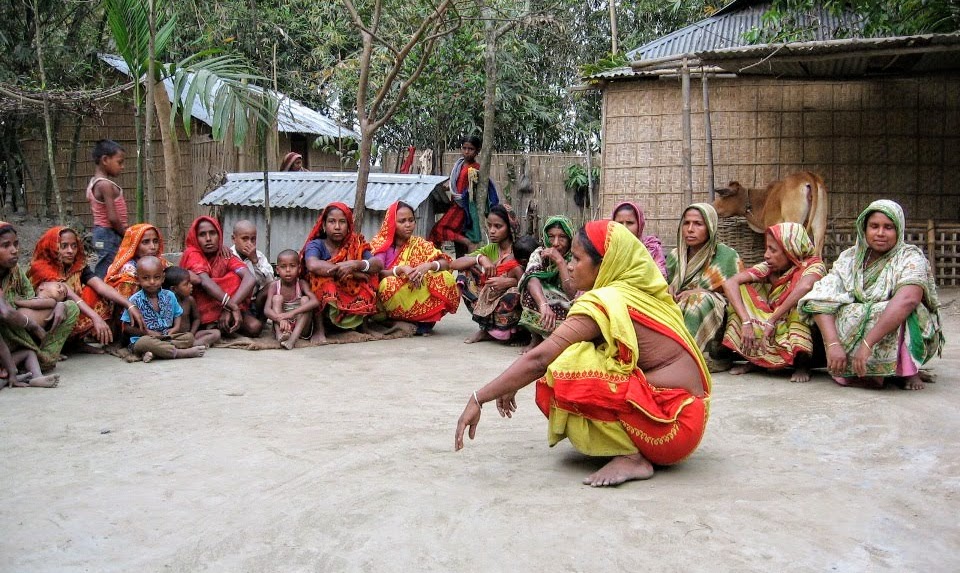THP recognizes and honors those in the most extreme poverty — what some call the “ultrapoor” — as “People’s Researchers” — capable of analyzing the systemic causes of their poverty via Participatory Action Research (PAR) and creating strategies to overcome them. In each village, they form a GGS: Gono Gobeshona Shomity or Self-Help Group.
Foundation of the organization: Collective Thinking, Collective Strength
With time, different types of problems are always arising in life. We can divide these problems in two ways. Firstly, daily life related problems such as food, work, healthcare, education etc. Secondly, discriminatory laws, corruption, dowry, exploitation and deprivation etc. problems. A lot of these daily life problems can be solved by taking loans from GGS after accumulating the savings, and then taking initiatives for income generating activities.
But if the structural problems are not solved, the daily life problems will persist. Thus, the structural problems must be solved, which will help eradicating the daily life problems permanently. It is not easy for the primary organizations to solve the structural problems. That is why, there is no alternative to creating the organizations with a combination of men and women and developing these grass roots organizations on a larger scale. Because, it is possible to achieve success only by utilizing this united power to amend the laws by starting a movement and enact new laws, to pressurize the government for land reform, and to stop exploitation and corruption of those in power by applying the collective force. This is how the door will open to solve daily life and structural problems; to establish a poverty free society.
And these organizations will have to be developed only after practicing collective thinking step by step with the grassroots people. For this, the gradual process given below needs to be followed.
Successive steps to create the organization:
| First Step | Priority based selection of village or community Individual communication and research on the importance of GGS formation |
| Second Step | Workshop planning: Where? When? How many will attend? Who will bring who? |
| Third Step | Participatory Action Research Workshop Society analysis and importance of GGS formation Emphasis on discussion regarding loans and debt |
| Fourth Step | Primary member selection and enlistment Listing people who will be members |
| Fifth Step | Meeting for GGS formation By laws/Setting policies Leadership/Committee Types of savings Naming the GGS |
| Sixth Step | Discussion topics of the meeting Participatory Action Research on various topics related to life Works on enhancing awareness and skill/Collective thinking Savings Investment Discussing the policies of an ideal GGS Giving ideas related to the necessary ledgers and registers to manage the GGS Topic based research/Rights of the citizens |
8 Principles of GGS Management
| 1. Member Management | Members over 18 years of ageMembers- minimum 20, maximum 50Same career and same social class |
| 2. Formation of the Management Committee 7-13 Members | 1 President and 1 Vice-president 1 Secretary and 1 Joint-secretary 1 Accountant Member (remaining) |
| 3. Savings management | Regular savings (Monthly/Quarterly/Weekly) Save more money in good times, Increase the capital faster |
| 4. Investment Management | Invest in safe and profitable cases |
| 5. Transparent Account Management Members’ pass book Resolution book Ledger book | Maintaining personal pass book, Accounting, Savings, Microfinance Writing the decisions in the resolution books Writing accounts in the Ledger book Finalizing the accounts on monthly meetings Keeping joint bank account |
| 6. Leadership Development | Creating interest in each member to take responsibilities Skill achievement by every member to manage the GGS Everyone’s participation in decision making Changes in the duties at specific intervals |
| 7. Annual Meeting | Annual General Meeting (AGM)-once a year Total estimation of savings, investment and profit of the GGS New management committee selection |
| 8. Participatory | Regular issue-based PAR meeting |


